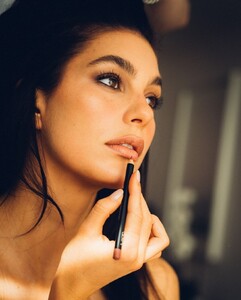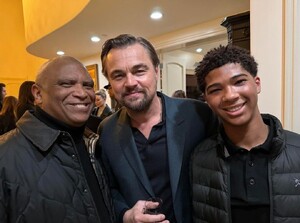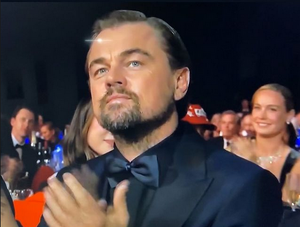
Everything posted by Jade Bahr
-
Leonardo DiCaprio - (Please Read First Post Prior to Posting)
@akatosh I finally watched THE HEIRESS and while Olivia de Havilland was really great the most upsetting part for me was actually her father and how he treatened her so terrible and loveless 😤 But otherwise than Mollie I could totally understand why she felt for Montgomery Clift here 😄 He's pure eye candy 🍭👀💋 The entire movie I was hoping her horrible father was wrong about him 😆 Also this made me chuckle lol #my dating life THE HEIRESS (1949) directed by William Wyler Now I have to watch "Wild River" the 3rd Montgomery Clift inspiration for KOTFM 😁 The 4th one "Red River" (how confusing) also with Montgomery Clift and John Wayne seems to reflect the Leo/De Niro dynamic. Martin Scorsese names the movies that inspired ‘Killers of the Flower Moon’
- Camila Morrone
- Claire Danes
-
Camila Morrone
- Books you are reading
Great character study of how to become a mass murderer- Watching right now
- Leonardo DiCaprio - (Please Read First Post Prior to Posting)
Once again some very nice words about Leo Reginald Hudlin, Leonardo Di Caprio and Alexander Hudlin at a celebration of Martin Scorsese’s KILLERS OF THE FLOWER MOON at the home of Mike and Irena Medavoy. In addition to being a magnificent actor, Leonardo is a wonderful person. He was lovely to my son, who he briefly met at craft service in the set of DJANGO UNCHAINED. He’s thoughtful, smart and hilarious. And if you haven’t seen the movie, it’s a crucial part of American history that needed to be told. Source- Emily Blunt
^Loved her CCA look 🌹- Lily Gladstone
- Leonardo DiCaprio - (Please Read First Post Prior to Posting)
Cara and Rachel 😍 Another win for Lily- Camila Morrone
- Nina Dobrev
Clear case of beauty over talent. She made TVD unwatchable. Not that is was a good show in the first place 😆- Leonardo DiCaprio - (Please Read First Post Prior to Posting)
- Leonardo DiCaprio - (Please Read First Post Prior to Posting)
It's really not a long period to vote. Thanks ALL for the updates- Margot Robbie
Critics Choice Awards, January 14, 2024.- Matthew Bomer
Someone's looking fine 💙- Lily Gladstone
- Last movie you saw...
Decent movie but horrible to watch.- Leonardo DiCaprio - (Please Read First Post Prior to Posting)
So is this meaning she's the Colin Farrell of the season (winning every small critic award but none of the major ones except Globe) and it's GONY all over again (lots of nominations but zero wins)? God that would be suck big times especially when the freaking comedy section barley wins in the history of oscars 😭 It's all about Murphy/Giamatti and Emma/Lily now I think. Everyone else is just "lucky" to get that oscar nom. Still there are people who think Murphy/Giamatti will split their votes and make Leo win when he's struggling to get even nominated. But like always I appreciate the never ending fan ambitions lol- Leonardo DiCaprio - (Please Read First Post Prior to Posting)
PTA’s New Film “Likely” A 2025 Release A few more notes about Paul Thomas Anderson’s next film, which is revving to begin production on January 22. All hands on deck for what will surely be a much-followed film, more details to come this week … Mark Bridges will not be costume designer on this film because of scheduling conflicts. This is the first time in 25 years that he won’t be working with PTA. They wanted to start shooting this film last summer, but the strikes put his entire schedule in flux. Also, Deadline’s Pete Hammond is reporting that PTA’s, still untitled, film is going to be in production in several locations around the country, and that it is likely going to be released in 2025. It’s said to be a 3-4 month shoot. So we’re looking at a production wrap, the latest, in May.- Leonardo DiCaprio - (Please Read First Post Prior to Posting)
Martys last attempt to get Leo that goddamn oscar nom 😄 It's kinda ironic though he worked the most with Leo but was never able to make Leo win the oscar... and probably never will. Martin Scorsese Says Leonardo DiCaprio is “One of the Greatest Actors in the History of Movies” Whenever the topic of Leonardo DiCaprio’s acting talents comes into conversation, it’s either he’s overrated or underrated, there’s no in-between. I’m sure that debate will continue on … And yet, DiCaprio has turned into an iconic American actor, one who never plays it safe, and always goes for risky, adventurous fare. I’ll admit that he’s been miscast in some films, but, when given the right role, he’s mesmerizing to behold. Forget about the star power, or good looks, for a second. There’s no doubt in my mind that DiCaprio is one of the most talented actors of his generation. However, is he one of the greatest ever? Time will tell. Martin Scorsese doesn’t believe in waiting, he is flat-out saying, in a just-leaked speech he gave at the NBR awards, that DiCaprio is most definitely an all-timer: He couldn’t make it here tonight for a really good reason … He’s right in the center doing prep for Paul Thomas Anderson’s new film […] So in 23 years, we made six pictures together now… I have faith in him. I know I can depend on him. His immersion in the process of the person who’s trying to play within the story is full. His fearlessness is something which has given me life when I make a film. I think this kind of really a times, maddening moment to search for what might be the truth of every character he plays. You know, he’s a genius in terms of cinema really is, and you could see it in the face. You could see it not only through the eyes, but he has the face of cinema. He doesn’t have to say a word. It’s all there. You could see it in all his films that he’s made going from ‘This Boy Life’ to the ‘Gilbert Grape’ picture, which was wonderful, all the way through the extraordinary ‘The Revenant.'” By the time we did ‘Aviator’ and ‘Departed,’ I felt a kind of resurgence of my own certain resurgence of my own energy, really, and in many ways, ‘Killers of the Flower Moon‘ is a culmination of all that work together. All the way up to the end when he’s at the witness stand. I knew I could just hold the camera on him and not cut away because I knew he would convey everything that was at that decisive moment. And we did one take, and I was moved on set, and that was it. One take, so I see him digging deeper into the corners of a human experience that many of us really can’t even bear to even acknowledge the weakness and the delusions of this guy in the film. You hate him but you tend to also love him … all the contradictions of what it is to be human. I really know he’s one of the truly one of the greatest actors in the history of movies. I thank him for everything. Scorsese saying DiCaprio is an all-timer means he believes that the actor belongs up there with the likes of Brando, Olivier, De Niro, Pacino, Day-Lewis, Nicholson, Bogart … That’s quite the statement from Scorsese, who has worked with DiCaprio on six movies, so far. It’s also not that surprising given that Scorsese keeps going back to working with DiCaprio. He sees something in him and it’s resulted in one of the more seminal actor/director partnerships in cinema. DiCaprio has been Oscar-nominated six times, and he’s won once (“The Revenant” in 2016). For years, cinephiles were shunning off DiCaprio due to his handsome good looks and the fandom he acquired because of “Titanic.” And yet, the years have been very kind to DiCaprio, in fact, he may be one of the very last old-school leads left in Hollywood.- Camila Morrone
- Last movie you saw...
- Leonardo DiCaprio - (Please Read First Post Prior to Posting)
@akatosh keep us informed about the winners girl- Last movie you saw...
- Books you are reading
Account
Navigation
Search
Configure browser push notifications
Chrome (Android)
- Tap the lock icon next to the address bar.
- Tap Permissions → Notifications.
- Adjust your preference.
Chrome (Desktop)
- Click the padlock icon in the address bar.
- Select Site settings.
- Find Notifications and adjust your preference.
Safari (iOS 16.4+)
- Ensure the site is installed via Add to Home Screen.
- Open Settings App → Notifications.
- Find your app name and adjust your preference.
Safari (macOS)
- Go to Safari → Preferences.
- Click the Websites tab.
- Select Notifications in the sidebar.
- Find this website and adjust your preference.
Edge (Android)
- Tap the lock icon next to the address bar.
- Tap Permissions.
- Find Notifications and adjust your preference.
Edge (Desktop)
- Click the padlock icon in the address bar.
- Click Permissions for this site.
- Find Notifications and adjust your preference.
Firefox (Android)
- Go to Settings → Site permissions.
- Tap Notifications.
- Find this site in the list and adjust your preference.
Firefox (Desktop)
- Open Firefox Settings.
- Search for Notifications.
- Find this site in the list and adjust your preference.
























